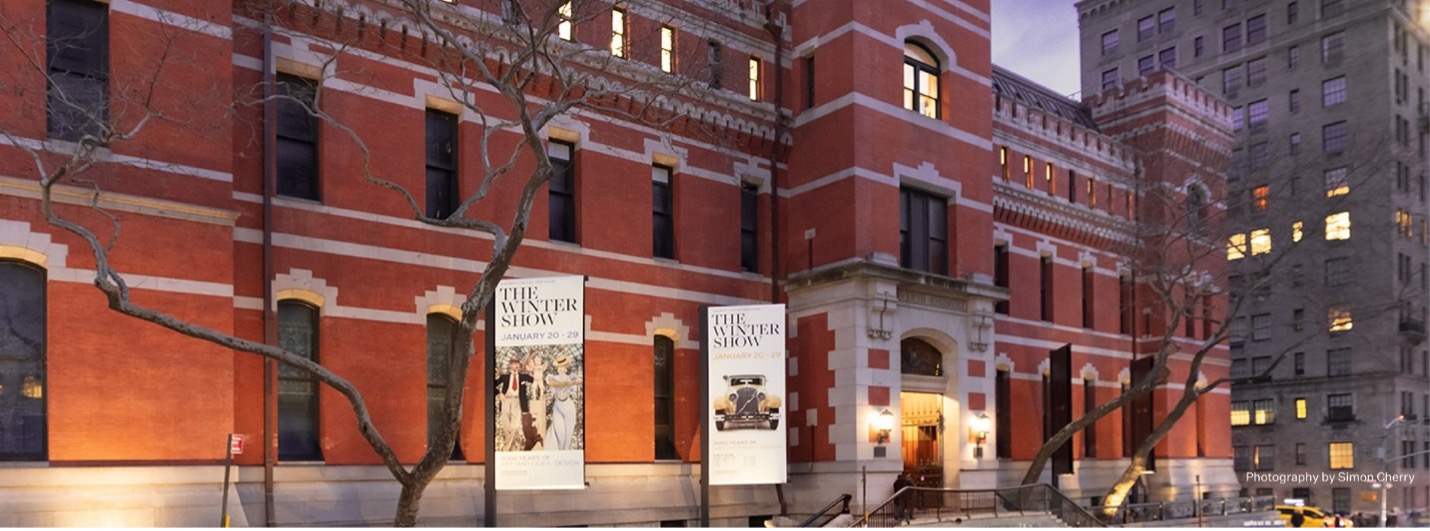My wife says that you know you’re getting old when you visit an antique store and recognize something from your past. “Oh, my grandmother had one of these!” you say, picking up a kitchen implement. “Oh, my mother had one of these!” you say, picking up something else. “Oh, I had one of these when I first got married,” you think, wondering where the time has gone.
Selling antiques is a tricky and ever-changing affair, as can be seen in The Winter Show, formerly The Winter Antiques Show, now being held at the Seventh Regiment Armory on Park Avenue in New York.

Courtesy Winter Show, Photograph by Simon Cherry
Premiering in 1955 as an exhibition to benefit the East Side House Settlement, the show soon established itself as the most prestigious antiques fair in the United States, an event that brought curators, designers, and collectors to New York from around the country each January.
But times change. What, today, constitutes an antique? “Antique” is in the eye of the beholder. Is a 1985 edition of a Mario Brothers video game an antique? Somebody thought it was worth $660,000 (see previous blog), so if it’s not an antique, it’s at least being regarded as a very special old thing. A school lunch box with Star Wars characters on it and a silver tray commemorating the accession of Queen Victoria – can they be seen in the same light? Both of them have utilitarian functions, but they also fall into the category of decorative art. Are we being snobs if we say that one of them is more worthy of aesthetic consideration than the other?
The market would say so. Antiques, to use the word in its traditional sense, have long been suspect to younger collectors, summoning up visions of an old fuddy-duddy admiring his collection of treen snuff boxes or portrait miniatures. That’s why, several years back, The Winter Antiques Show dropped the word “Antiques” and assumed its current name. There would still be antiques on offer at the fair, although the definition of “antique” became increasingly blurry. I seem to recall a rule, back when I participated in the show, that nothing made after 1965 could be shown, and I’m sure that the limiting date had already been rolled forward several times. Nowadays, contemporary objects can also be shown.
The buyers of antique works of art these days are generally people who intend to incorporate a particular piece into what previous generations of collectors would have dismissed as a hodgepodge instead of a collection, with all kinds of decorative objects on display. I don’t mean that to sound derogatory; I’m simply saying that connoisseurship has increasingly become the bailiwick of museum curators. That’s just the way things are now. Even museum curators are now exhibiting works from various periods and places side-by-side. I confess that the connections those curators attempt to demonstrate often seem extremely tenuous to me, but sometimes such juxtapositions put a familiar piece in a new and revealing light.
Well, get to The Winter Show if you can. It’s always worth seeing. I’m glad, however, that I’m not exhibiting there anymore. Most antique fairs run three or four days. The Winter Show runs a full ten days, and by the end every exhibitor is dog-tired. To make things worse, Gerald Peters Gallery, whose booth I manned, also participated in an antiques fair in Palm Beach that opened only a couple of days after The Winter Show closed. I would pack up the artwork in New York and catch a plane for Palm Beach.
I quickly learned that you get no sympathy from New Yorkers in winter if you complain that you have to go to Palm Beach, even if you just worked ten days straight and are looking at another seven days’ worth. “Boy,” people would say, arching an eyebrow, “some people sure have it tough!” I would remonstrate that I was going to be standing in a booth all day and that if I wanted to sit on a beach in a Speedo, I’d have to do so late at night. Actually, given how I would look in a Speedo, late at night might have been the best for all concerned.

